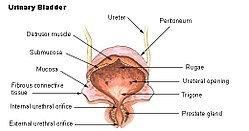Internal urethral sphincter
| Internal sphincter muscle of urethra | |
|---|---|
 Coronal section of anterior part of pelvis, through the pubic arch. Seen from in front. (Region visible, but muscle not labeled.) | |
 Urinary bladder (Region visible, but muscle not labeled.) | |
| Details | |
| Origin | The inferior ramus of the pubic bone |
| Insertion | Perineal raphe |
| Nerve | Sympathetics from L1-L2 through lumbar splanchnic nerves. Parasympathetics from S2-S4 through inferior hypogastric plexus. |
| Actions | Sympathetic contracts and parasympathetic relaxes the muscle |
| Identifiers | |
| Latin | Musculus sphincter urethrae internus |
| TA98 | A09.2.03.009 A09.4.02.013 |
| TA2 | 3444, 3428 |
| FMA | 45769 |
| Anatomical terms of muscle | |
The internal sphincter muscle of urethra is a urethral sphincter muscle which constricts the internal urethral orifice. It is the junction of the urethra with the urinary bladder. The muscle is made of smooth muscle, so therefore it is under involuntary control. It is kept tonically contracted by Lumbar plexus of the sympathetic nervous system.
Function
During micturition it is relaxed via branches from the inferior hypogastric plexus (S2-S4) parasympathetic nervous system. This is the primary muscle for maintenance of continence of urine. Its two major roles are:
- Prevent urine leakage as the muscle is contracted via sympathetic stimulation (via the Lumbar Splanchnic nerves).
- During ejaculation, the contraction of the muscle prevents reflux of semen in the urinary bladder.
- Note that female does not have an internal urethral sphincter because her urinary system is not connected with the reproductive system like males
